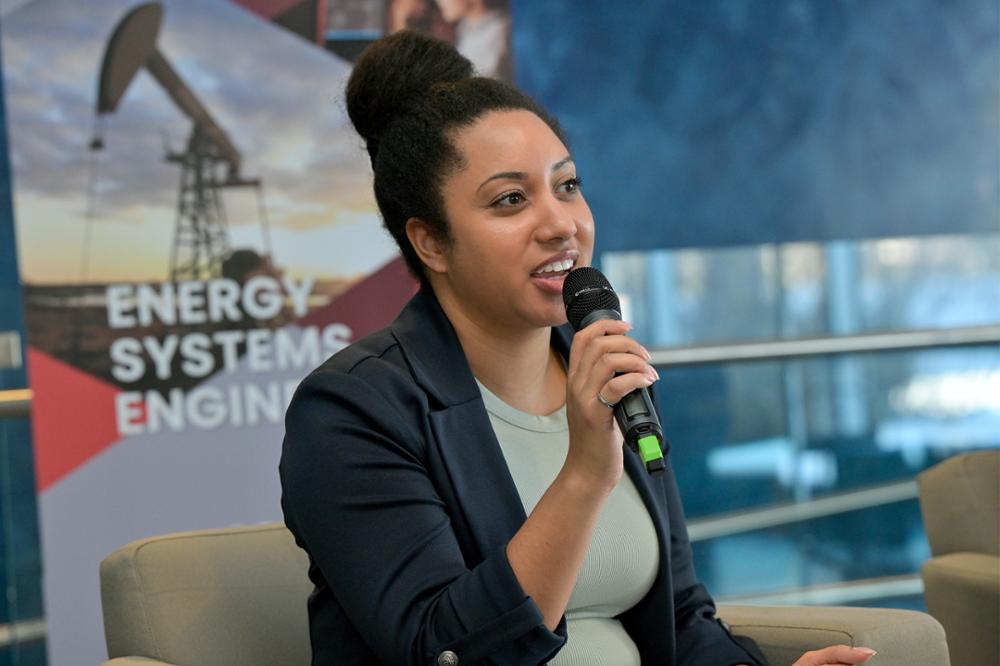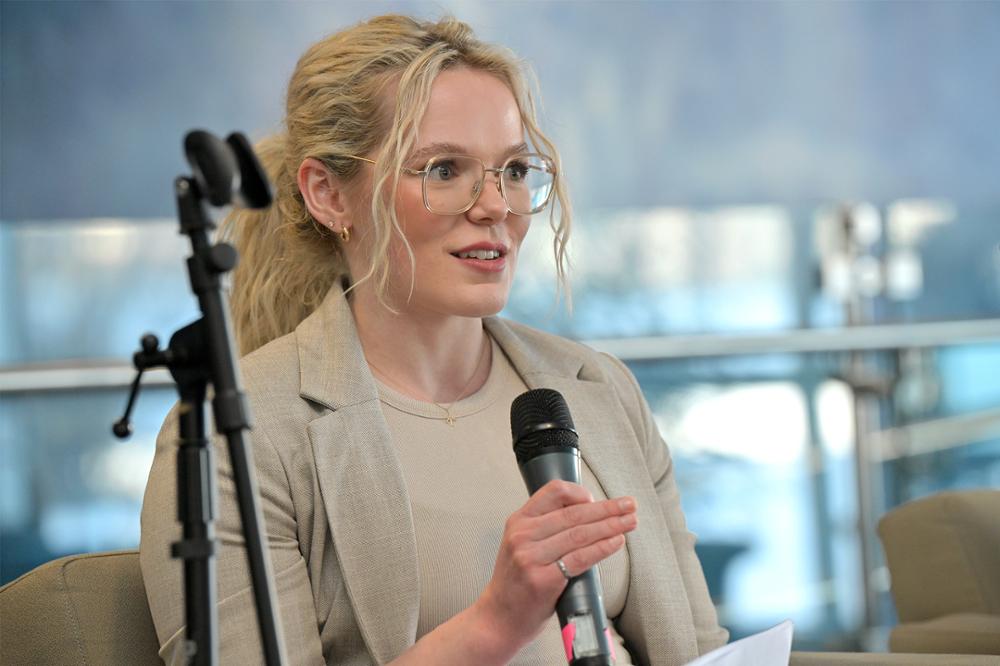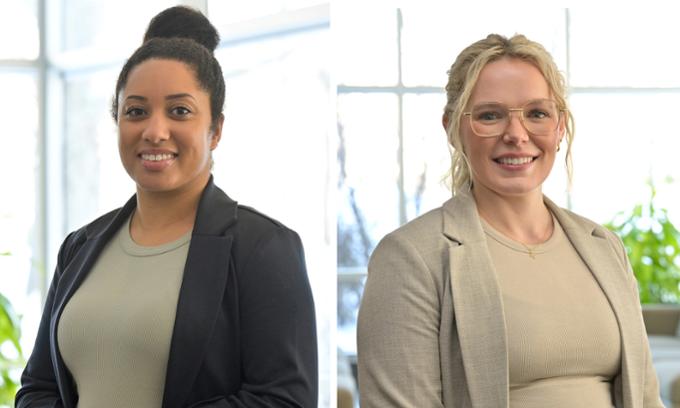Patricia Pryce BASc’15 and Kendall Sampson-Kitzul BASc’18 are both University of Regina alum, female engineers, and inspirations to the next generation of women and girls interested in a career in STEM.
Patricia Pryce P.Eng.
Patricia Pryce P.Eng. has built herself a successful career in pipeline engineering. After working with TransGas Limited for more than eight years, the Petroleum Systems Engineering alum is now a Senior Engineer, Pipeline Facilities Engineering with SaskEnergy.
Pryce says that her time at the U of R was well spent, as it gave her a solid foundation to begin her career, and to progress professionally ever since. As part of her U of R experience, Pryce was place in a co-op work term with TransGas Limited, which led to her obtaining her first permanent engineering role after graduation.
There will be times in your career where you need to turn to trusted individuals on how to handle challenges, discuss career development opportunities, and just lean on for advice. If you can have one or two people in that network meet regularly with you to provide mentorship, even better. — Kendall Sampson-Kitzul P.Eng.
“The experience I was able to gain through my co-op work terms was invaluable,” says Pryce. “I could see the direct correlation between my studies and the real world. The things I read about and used in calculations in my coursework, I then saw in action in a facility. The co-op work terms helped me solidify that I would enjoy working in the field I was studying in.”
When it comes to other women or girls who are considering a career in engineering, Pryce advises them to just go for it! In addition to engineering being an excellent career choice, she says that the transferrable skills that engineers have help to form you into a well-rounded individual, which is another benefit that is valuable even outside of work.

“Becoming an engineer has been one of the best decisions I have made,” says Pryce. “Engineering covers a variety of fields and industries so you can find which area suits you best, and thrive in it.”
Pryce’s favourite part about her career is that it is challenging, while also requiring a level of creativity and thinking outside the box. This has kept both her job, and her career as a whole, interesting.
“I am always learning and developing my technical knowledge which is rewarding,” says Pryce. “I also love that I can be an example to other young females and to my daughter, and show them that you can achieve anything you set your mind to.”
Kendall Sampson-Kitzul P.Eng.
After completing a Bachelor of Applied Science in Industrial Systems Engineering, Kendall Sampson-Kitzul P.Eng. has gone on to have a successful career with The Mosaic Company, where she is currently an Applied Process Technology Engineer.
When she was growing up, Sampson-Kitzul was always drawn to sciences and maths. She knew the two subjects could be even more powerful when combined, and this ultimately lead her to engineering. At first, she wasn’t sure which engineering path she wanted to take, but that all changed when she was placed in a co-op work term with The Mosaic Company during her studies at the U of R.
“During my work term with Mosaic, I met an inspiring young female engineer, who was a mentor and now friend, and she introduced me to Reliability Engineering,” says Sampson-Kitzul. “It was there at Mosaic that I felt the Industrial Systems program would be the best fit for me. I could picture myself starting my Engineering career in that area.”

Throughout her career, Sampson-Kitzul has experienced being the only female in the room, or one of a few. She says that this has led to many positive experiences, including forming a bond with other female engineers and other women in the workplace. In addition, she has had a lot of male leaders and colleagues who have been friends and allies, and helped to create an enjoyable work atmosphere.
“My best advice to younger women is to build your network, both internally at your school or company, and externally,” says Sampson-Kitzul. “There will be times in your career where you need to turn to trusted individuals on how to handle challenges, discuss career development opportunities, and just lean on for advice. If you can have one or two people in that network meet regularly with you to provide mentorship, even better.”
Between her co-op work term and securing full-time employment with The Mosaic Company, Sampson-Kitzul has had the opportunity to work at different sites and explore other aspects of engineering applications in mining. The skills, knowledge, and diverse professional relationships formed while working in mining operations have enabled her to bring a unique perspective to her current role in Mosaic's Applied Process Technology Department developing their metallurgical and corrosion sciences research.
Interested in a career in Engineering? Check out Engineering Project Day this weekend! On April 6, fourth-year Engineering students will present their final-year capstone projects, in addition to a Trade Show and Poster Session where their innovative projects will be on display. Everyone is welcome!
She is also passionate about getting more young women exposed to mining and engineering at an early age, so that the experience stays with them and that the fields are in the running when eventually considering potential career paths.
“In addition to the work I do in my career, I also love spreading the word - as a Mosaic Ambassador and volunteer with Women in Mining/Women in Nuclear Saskatchewan - about women in engineering and careers for women in mining,” says Sampson-Kitzul. “I think that getting youth interested, engaged, and involved in the opportunities early is how we will get more young women interested in engineering.”
Banner photo credit: U of R Photography.
About the University of Regina
2024 marks our 50th anniversary as an independent University (although our roots as Regina College date back more than a century!). As we celebrate our past, we work towards a future that is as limitless as the prairie horizon. We support the health and well-being of our 16,700 students and provide them with hands-on learning opportunities to develop career-ready graduates. Our research enterprise has grown to include 21 research centres and 12 Canada Research Chairs and brings in more than $51.2 million in funding annually. Our campuses are on Treaties 4 and 6 - the territories of the nêhiyawak, Anihšināpēk, Dakota, Lakota, and Nakoda peoples, and the homeland of the Michif/Métis nation. We seek to grow our relationships with Indigenous communities to build a more inclusive future.
Let’s go far, together.
